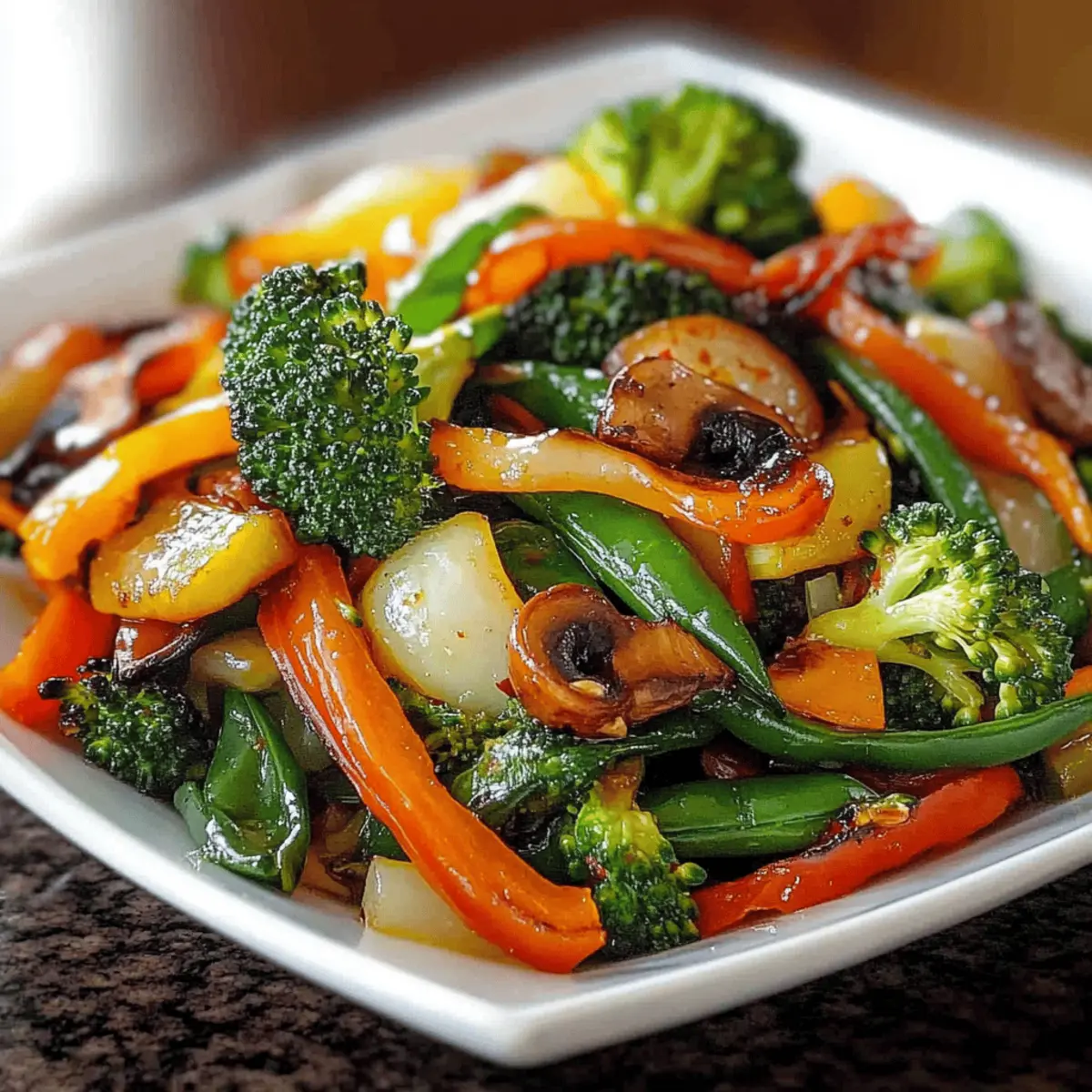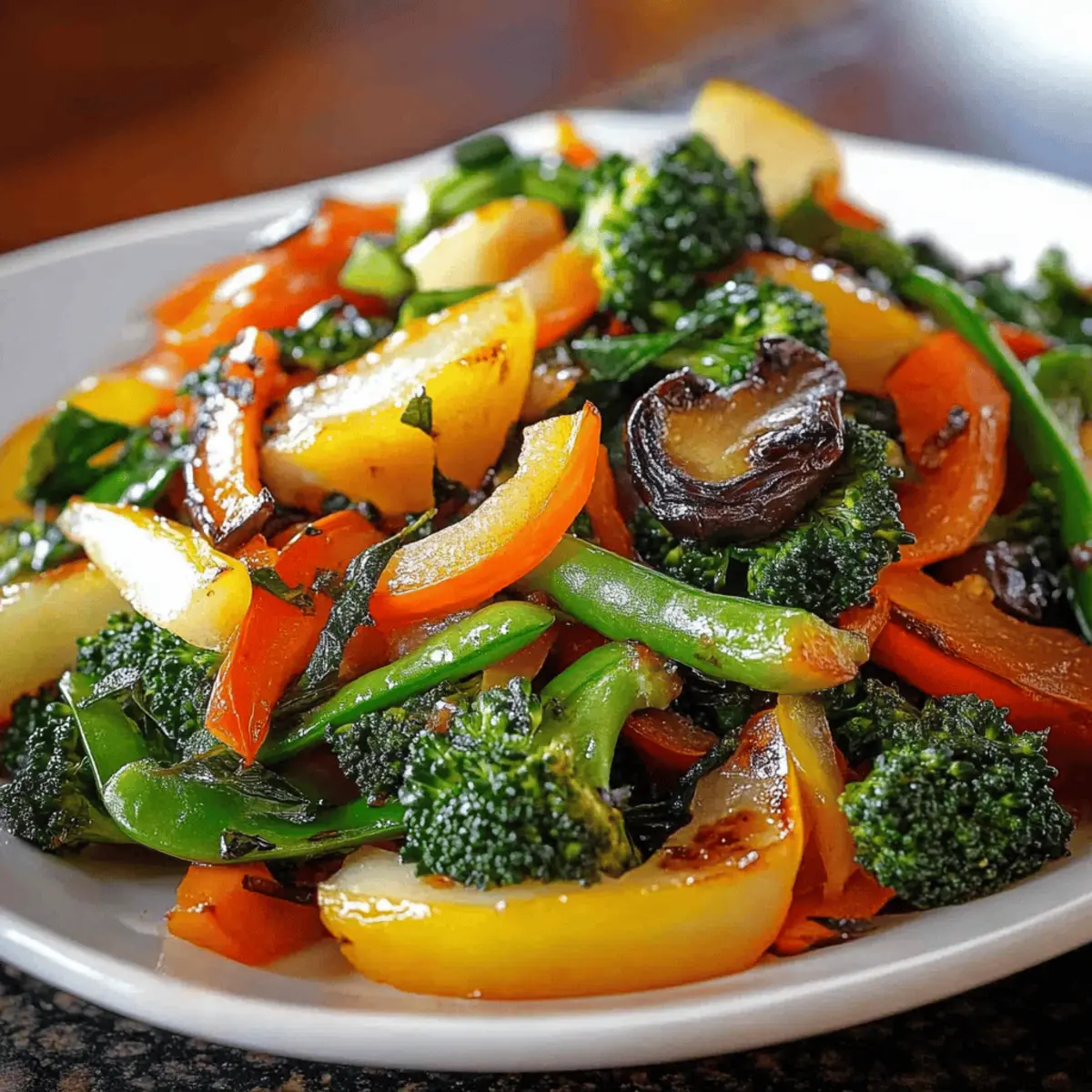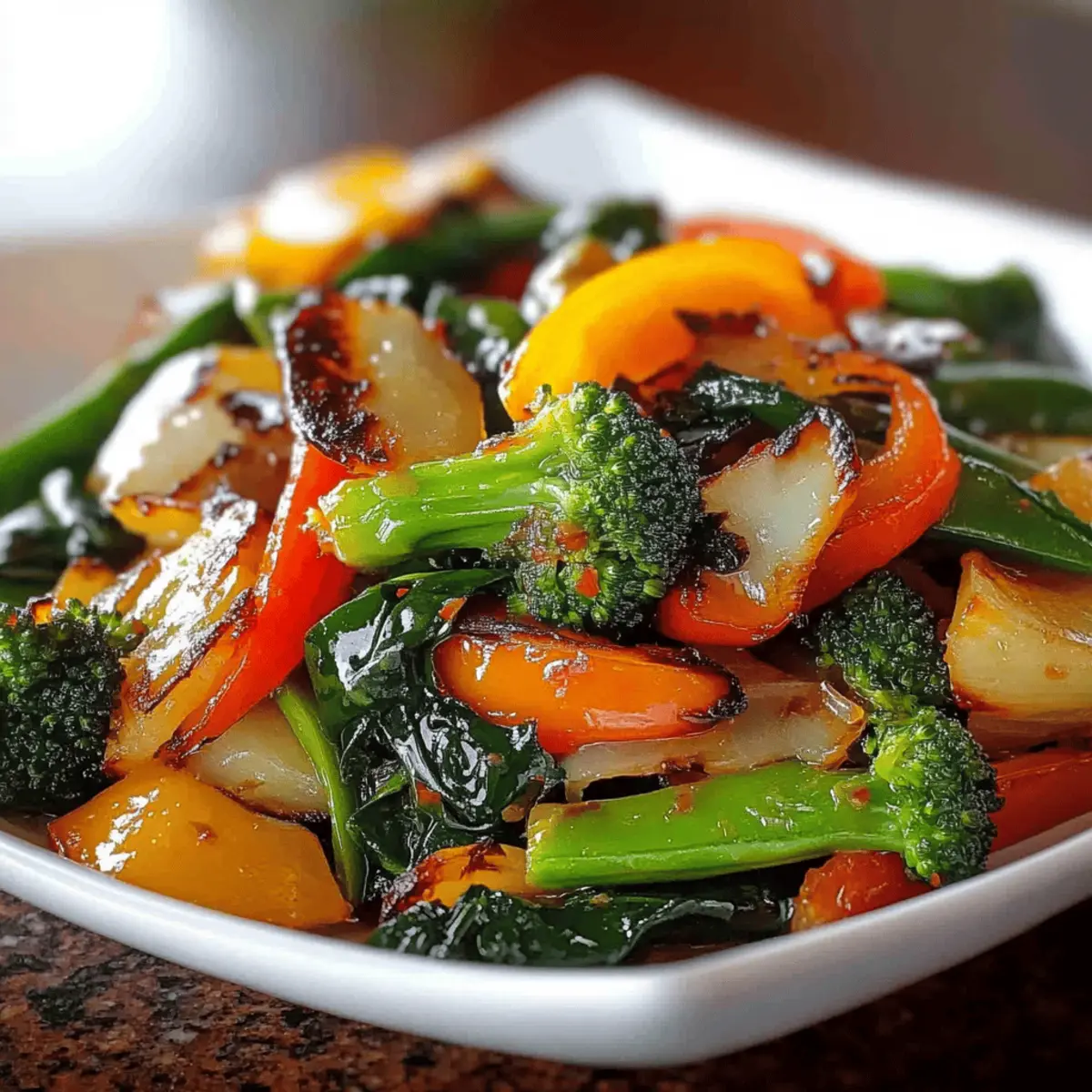As the vibrant colors of fresh vegetables danced before my eyes, a wave of inspiration struck. I could almost smell the tempting aroma of healthy sautéed vegetables wafting through the air. This Quick & Colorful Sautéed Vegetables recipe transforms everyday produce into an easy-to-make side dish that brings vitality to any meal. Perfect for busy weeknights or meal prep, it’s not only a delightful way to incorporate seasonal veggies but also a fantastic option for those eager to enjoy healthy, satisfying dishes without fuss. Packed with nutrition and flavor, this recipe can be customized to suit your taste preferences and dietary needs. Are you curious about how to elevate your vegetable game with irresistible twists? Let’s dive in!

Why Are Sautéed Vegetables So Irresistible?
Simplicity at its finest: With just a handful of fresh ingredients, this recipe transforms basic vegetables into a delightful dish in no time. Vibrant Colors abound: From bell peppers to snap peas, the rainbow of veggies adds visual appeal that excites the palate. Customizable Flavor: Whether you prefer a Mediterranean flair or an Asian twist, simply adjust the seasonings and toppings to suit your cravings. Healthy Benefits: Packed with vitamins and antioxidants, these sautéed vegetables are a nourishing boost to any meal. Perfect for meal prep, just pair them with some grilled chicken or Healthy Pumpkin Oat cookies for a delectable, wholesome feast!
Healthy Sautéed Vegetables Ingredients
• Dive into the colorful components of this delightful dish!
- Olive Oil (2 tbsp) – Acts as the cooking medium, adding flavor; substitute with avocado oil or butter for variation.
- Garlic (2 cloves, minced) – Adds aromatic depth; fresh garlic provides the best flavor, but garlic powder can work in a pinch.
- Onion (1 small, thinly sliced) – Provides sweetness and texture; red or yellow onions can be used based on your preference.
- Bell Pepper (1, sliced) – Adds color and sweetness; any color (red, yellow, green) lights up the dish beautifully.
- Zucchini (1 medium, sliced into half-moons) – Offers a tender texture that absorbs flavors well; yellow squash is a lovely alternative.
- Broccoli (1 cup, florets) – Adds a healthy crunch and nutrients; cauliflower serves as a great alternative.
- Carrot (1 medium, julienned) – Provides color and sweetness; baby carrots can be a convenient time-saver.
- Snap Peas (½ cup) – Introduces a sweet crunch; green beans can be a suitable substitute.
- Mushrooms (½ cup, sliced) – Introduces umami flavor and texture; any variety like oyster or shiitake are excellent choices.
- Salt & Black Pepper – Essential for seasoning; adjust to your taste for the perfect balance.
- Lemon Juice (1 tsp, optional) – Brightens flavors at the end of cooking, or substitute with vinegar for a different zing.
- Balsamic Vinegar or Soy Sauce (1 tsp, optional) – Adds depth and umami; choose based on your desired flavor profile.
- Optional Toppings: – Toasted nuts, seeds, fresh herbs, or grated Parmesan add delightful crunch and flavor enhancement.
Embrace the scrumptious world of Healthy Sautéed Vegetables with this colorful ingredient list and savor the vibrant flavors!
Step‑by‑Step Instructions for Healthy Sautéed Vegetables
Step 1: Prep the Vegetables
Begin by washing all vegetables thoroughly. Peel the carrots and slice the onion, bell pepper, zucchini, and mushrooms into uniform pieces. Cut the broccoli into florets and julienne the carrot, ensuring all vegetables are approximately the same size for even cooking. This preparation will enhance the visual appeal and ensure that every bite of your healthy sautéed vegetables is delightful.
Step 2: Heat the Pan
In a large skillet, pour in 2 tablespoons of olive oil and place it over medium-high heat. Allow the oil to heat for about 1-2 minutes, or until it shimmers slightly. A well-heated pan will help achieve that perfect sautéed texture. Make sure to swirl the oil around the pan to coat the surface evenly, preparing it for the next step.
Step 3: Cook Aromatics
Add the minced garlic and sliced onions to the hot oil, sautéing for about 1-2 minutes. Stir continuously until the onions become translucent and fragrant. This step creates a flavorful base for your healthy sautéed vegetables, allowing the aromatics to infuse the oil and enhance the overall dish’s flavor.
Step 4: Add Harder Vegetables
Introduce the chopped carrots and broccoli to the skillet, stirring frequently. Cook them for approximately 3-4 minutes, until they begin to soften while maintaining a bit of crunch. This step adds a vibrant texture and ensures that the heartier vegetables are cooked perfectly, allowing them to soak up the aromatic flavors.
Step 5: Incorporate Softer Vegetables
Next, add the bell pepper, zucchini, mushrooms, and snap peas to the skillet. Sauté the mixture for an additional 4-5 minutes, continuously stirring until they are crisp-tender. The combination of colors and flavors creates an enticing aroma, and the vegetables should look just bright and vibrant when they’re done.
Step 6: Season & Finish
Sprinkle salt and black pepper to taste over the sautéed vegetables, tossing well to combine. If desired, drizzle with 1 teaspoon of lemon juice or balsamic vinegar for an extra flavor boost. Continue to cook for another minute, ensuring that all vegetables are nicely seasoned and coated. Serve your healthy sautéed vegetables warm, garnished with optional toppings for a delightful finish.

Make Ahead Options
These Healthy Sautéed Vegetables are fantastic for meal prep, allowing you to enjoy vibrant, nutritious dishes with ease! You can chop and prepare the vegetables up to 24 hours in advance—simply keep them stored in an airtight container in the refrigerator. For optimal freshness and to prevent browning, vegetables like zucchini and bell peppers should be cut just before sautéing. When you’re ready to serve, just sauté the prepared veggies in olive oil as described in the recipe; they’ll taste just as delicious as if freshly cooked. This time-saving strategy ensures that you can whip up a colorful, healthy side dish even on the busiest of weeknights!
Expert Tips for Healthy Sautéed Vegetables
-
Uniform Cuts: Ensure your vegetables are cut into similar sizes for even cooking; this helps achieve that perfect texture in your healthy sautéed vegetables.
-
High Heat: Maintain medium-high heat throughout the cooking process to prevent steaming; this ensures a crisp-tender finish and vibrant colors.
-
Layer Flavors: Start with aromatics like garlic and onion, then gradually add vegetables based on cooking time; avoid adding all at once to prevent sogginess.
-
Prep Ahead: Chop and prep your vegetables in advance for quick cooking during hectic weeknights, making your healthy sautéed vegetables even easier to whip up.
-
Experiment Freely: Don’t hesitate to mix up the seasonings; try herbs, spices, or different sauces to customize the flavor profile to your preference.
How to Store and Freeze Healthy Sautéed Vegetables
- Fridge: Store leftovers in an airtight container for up to 3-4 days. This keeps your delicious healthy sautéed vegetables fresh and ready to reheat for a quick meal.
- Freezer: For longer storage, freeze sautéed vegetables in a single layer on a baking sheet, then transfer to airtight containers for up to 2 months. This allows for easy portioning later.
- Reheating: Reheat in a skillet over medium heat for 5-7 minutes, stirring occasionally, to maintain the crisp-tender texture of your healthy sautéed vegetables. Avoid microwaving to prevent sogginess.
- Make-Ahead: If planning to freeze, sauté vegetables until they’re slightly undercooked to preserve their flavor and texture after thawing.
What to Serve with Healthy Sautéed Vegetables
Elevate your meal with delightful pairings that enhance the vibrant flavors of your vegetables.
- Quinoa Pilaf: This nutty grain adds a wholesome, hearty element, perfectly absorbing the savory juices from the sautéed veggies.
- Grilled Chicken Breast: A protein-packed option that complements the freshness of the vegetables, making for a balanced and satisfying dish.
- Crispy Tofu Bites: The crispy exterior and tender inside of tofu provide a delicious contrast; perfect for a vegan-friendly meal that’s filling and flavorful.
- Brown Rice: With its nutty flavor and chewy texture, brown rice creates a nourishing base for these sautéed vegetables, turning it into a complete meal.
- Garlic Bread: The crunch and aroma of garlic bread not only satisfy cravings but also serve as the ideal sidekick to scoop up those colorful veggies!
- Lemon Herb Dressing: Drizzle this tangy dressing over grain bowls or salads for a refreshing kick that vibrantly complements your sautéed vegetables.
- Herb-Infused Couscous: Light and fluffy, herb-infused couscous adds a fragrant touch, soaking up the wonderful flavors of the sautéed vegetables.
- Watermelon Salad: The sweet, juicy contrast provides a refreshing counterpoint, balancing the savory notes of your healthy sautéed vegetables.
- Lemonade or Iced Tea: Sip on a refreshing drink that echoes the zesty notes of lemon in your sautéed veggies, enhancing the whole dining experience.
- Chocolate Avocado Mousse: For a delightful finish, this rich and creamy dessert marries health with indulgence, making your meal truly memorable.
Healthy Sautéed Vegetables Variations
Feel free to explore these exciting twists on your healthy sautéed vegetables to truly make the dish your own!
-
Dairy-Free: Skip the cheese and try nutritional yeast sprinkled on top for a cheesy flavor without dairy.
-
Herb-Infused: Add fresh herbs like basil, cilantro, or parsley towards the end of cooking for a fragrant lift. The fresh herbs will transform the dish, making each bite taste like summer!
-
Spicy Kick: Add red pepper flakes or fresh jalapeños to the skillet for a heat boost that tantalizes the taste buds. It’s a surefire way to awaken your vegetables and spice up your meal!
-
Citrus Zest: Mix in some orange or lime zest along with the lemon juice for an unexpected burst of freshness that brightens the dish.
-
Nutty Surprise: Toss in a handful of toasted almonds, cashews, or walnuts at the end for added crunch and flavor. The nuttiness will complement the vegetables beautifully, making for a delightful texture contrast.
-
Sweet and Savory: Caramelize onions longer until they are golden, then add a splash of balsamic vinegar for a beautifully balanced flavor profile. This takes your sauté to a whole new level of deliciousness.
-
Add Protein: Toss in cooked quinoa or lentils to bulk up your sautéed vegetables into a hearty meal. Pair it with some grilled chicken or even the scrumptious Chicken Parmesan for a satisfying dinner.
-
Stir-Fry Fusion: Swap out olive oil for sesame oil and add soy sauce and sesame seeds to create a mouthwatering Asian-inspired dish. It’s like bringing the flavors of a bustling market straight to your kitchen!
Whichever variation you choose, remember that the essence of this dish is its adaptability. Enjoy experimenting with flavors until you find your perfect combination!

Healthy Sautéed Vegetables Recipe FAQs
What vegetables are best for sautéing?
Absolutely! A mix of colorful vegetables like bell peppers, zucchini, broccoli, and carrots work wonderfully. Vegetables should be fresh and crisp; avoid those with dark spots or wilting. Feel free to get creative and mix any seasonal produce you enjoy!
How long can I store sautéed vegetables in the fridge?
Store your healthy sautéed vegetables in an airtight container for up to 3-4 days in the fridge. Reheating them in a skillet is best to maintain their texture and flavors, making for easy, wholesome meals throughout the week.
Can I freeze sautéed vegetables?
Very! For freezing, first sauté your vegetables until they are just slightly undercooked. Spread them out on a baking sheet to freeze in a single layer for a couple of hours. Transfer them to airtight containers or freezer bags, ensuring to remove excess air. You can enjoy them within 2 months for the best flavor!
What if my sautéed vegetables are soggy?
If you’ve ended up with soggy vegetables, they likely weren’t cooked at the right temperature or were overcrowded in the pan. For the best results, always sauté over medium-high heat and work in batches if needed to prevent steaming. If they’ve already turned soggy, try crisping them up in the skillet for a few more minutes to regain some texture.
Are sautéed vegetables suitable for a vegan diet?
Absolutely! This healthy sautéed vegetables recipe is wholly vegan, but do check seasoning options like soy sauce to ensure they fit your dietary preferences! You can also enhance them with nutritional yeast for an extra cheesy flavor without dairy.

Deliciously Healthy Sautéed Vegetables in Just 15 Minutes
Ingredients
Equipment
Method
- Begin by washing all vegetables thoroughly. Peel the carrots and slice the onion, bell pepper, zucchini, and mushrooms into uniform pieces. Cut the broccoli into florets and julienne the carrot, ensuring all vegetables are approximately the same size for even cooking.
- In a large skillet, pour in 2 tablespoons of olive oil and place it over medium-high heat. Allow the oil to heat for about 1-2 minutes, or until it shimmers slightly.
- Add the minced garlic and sliced onions to the hot oil, sautéing for about 1-2 minutes until the onions become translucent and fragrant.
- Introduce the chopped carrots and broccoli to the skillet, stirring frequently. Cook them for approximately 3-4 minutes, until they begin to soften while maintaining a bit of crunch.
- Next, add the bell pepper, zucchini, mushrooms, and snap peas to the skillet. Sauté the mixture for an additional 4-5 minutes, continuously stirring until they are crisp-tender.
- Sprinkle salt and black pepper to taste over the sautéed vegetables, tossing well to combine. If desired, drizzle with 1 teaspoon of lemon juice or balsamic vinegar for an extra flavor boost.
- Serve your healthy sautéed vegetables warm, garnished with optional toppings for a delightful finish.

Leave a Reply